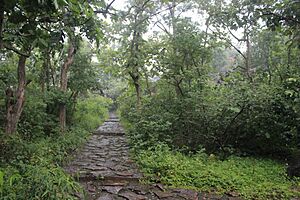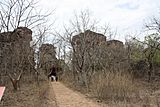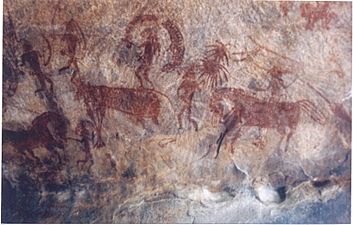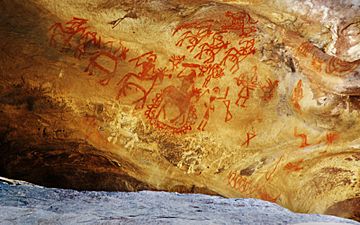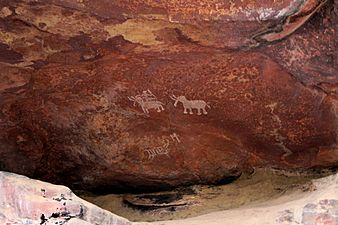Bhimbetka rock shelters facts for kids
| UNESCO World Heritage Site | |
|---|---|
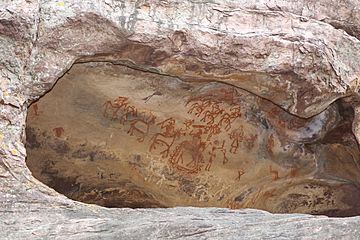
Bhimbetka rock painting
|
|
| Location | Raisen District, Madhya Pradesh, India |
| Criteria | Cultural: |
| Inscription | 2003 (27th Session) |
| Area | 1,893 ha (7.31 sq mi) |
| Buffer zone | 10,280 ha (39.7 sq mi) |
The Bhimbetka rock shelters are amazing ancient caves and shelters in central India. They show us how people lived from the Paleolithic (Old Stone Age) and Mesolithic (Middle Stone Age) periods, all the way to more recent times. Scientists have found the oldest signs of human life in India here, going back to the early Stone Age.
These shelters are in the Raisen District of Madhya Pradesh, about 45 kilometers (28 miles) south-east of Bhopal. Bhimbetka is a UNESCO World Heritage Site. It has seven hills and over 750 rock shelters spread across 10 kilometers (6 miles). Some of these shelters were home to people more than 100,000 years ago!
The rock shelters and caves give us clues about how humans settled down. They show how people changed from being hunter-gatherers (who found their food) to farmers. They also show us early signs of spiritual beliefs.
Many of the Bhimbetka rock shelters have ancient cave paintings. The oldest ones are from about 10,000 BCE, which is during the Indian Mesolithic period. These paintings show animals, early dances, and hunting scenes from the Stone Age. Later paintings show warriors on horseback, possibly from the Bronze Age. Bhimbetka has the oldest known rock art in India and is one of the largest prehistoric sites.
Contents
Where are the Bhimbetka Rock Shelters?
The Rock Shelters of Bhimbetka are located 45 kilometers (28 miles) south-east of Bhopal. They are also 9 kilometers (5.6 miles) from Obedullaganj city. The site is in the Raisen District of Madhya Pradesh.
It sits at the southern edge of the Vindhya Range of hills. South of these shelters are the Satpura hills. The site is inside the Ratapani Wildlife Sanctuary. It is built into sandstone rocks at the foot of the Vindhya Range. The area has seven main hills: Vinayaka, Bhonrawali, Bhimbetka, Lakha Juar (east and west), Jhondra, and Muni Babaki Pahari.
What Does Bhimbetka Mean?
The Story Behind the Name
The name Bhimbetka means "Bhima's resting place" or "Bhima's lounge." It comes from two words: Bhima and Baithaka. Bhima was a very strong character from the ancient Indian story, the Mahabharata. He was the second of the five Pandava brothers.
Local people believe that Bhima rested here during his time of exile. They say he would meet and talk with the people living in the area.
How Were the Shelters Discovered?
A British official named W. Kincaid first wrote about Bhimbetka in 1888. He heard about it from local tribal people. They told him about Bhojpur lake nearby. Kincaid thought Bhimbetka might be a Buddhist site.
The first archaeologist to visit some caves and realize their ancient importance was V. S. Wakankar. He saw these rock formations in 1957. He thought they looked like similar sites he had seen in Spain and France. He then visited the area with a team and found many prehistoric rock shelters.
It wasn't until the 1970s that people truly understood how big and important the Bhimbetka rock shelters were. Since then, over 750 rock shelters have been found. The main Bhimbetka group has 243 shelters. The nearby Lakha Juar group has 178 shelters.
The Archaeological Survey of India says that humans lived here continuously. They lived here from the Stone Age, through the early and late Mesolithic periods, until about 200 BCE. This information comes from digging up the site. They found old tools, goods, colors used in paintings, and the rock paintings themselves.
The site also has some of the world's oldest stone walls and floors. In 1990, the site was protected under Indian laws. It came under the care of the Archaeological Survey of India. In 2003, UNESCO declared it a World Heritage Site.
The Auditorium Cave
Among the many shelters, the Auditorium cave is very special. It is surrounded by tall quartzite rock towers. You can see these towers from far away. The Auditorium rock is the largest shelter at Bhimbetka.
Archaeologist Robert G. Bednarik said the Auditorium cave feels like a "cathedral." He described its "Gothic arches and soaring spaces." Its shape looks like a "right-angled cross." Its four parts point to the four main directions (north, south, east, west). The main entrance faces east.
At the end of this eastern path, near the cave's entrance, is a large rock. It has a nearly straight side that stands out. You can see it from all directions. In archaeology books, this rock is called "Chief's Rock" or "King's Rock." However, there is no proof it was used for special ceremonies. This large rock and the Auditorium cave are central to Bhimbetka. They are surrounded by 754 numbered shelters and nearly 500 places with rock paintings.
Amazing Rock Art and Paintings
The rock shelters and caves of Bhimbetka have many paintings. Some of the oldest paintings are from 10,000 BCE. But some of the geometric shapes are as recent as the medieval period.
V. S. Wakankar divided the drawings and paintings into seven different time periods. He believed the earliest paintings, from the Upper Paleolithic period, could be as old as 40,000 years. The artists used colors made from plants. These colors have lasted a very long time because the drawings were often made deep inside the caves or on inner walls.
- Period I – (Upper Paleolithic): These are simple line drawings in green. They show humans dancing and hunting.
- Period II – (Mesolithic): These figures are smaller and more detailed. They have patterns on their bodies. Besides animals, there are human figures and hunting scenes. They show the weapons people used, like spears, pointed sticks, and bows and arrows. Some scenes might show tribal wars. Other paintings show group dances, birds, musical instruments, mothers and children, pregnant women, and people carrying dead animals. They also show drinking and burials.
- Period III – (Chalcolithic): These paintings are similar to the Mesolithic ones. They show that cave dwellers traded goods with farming communities from the Malwa plains.
- Period IV & V – (Early Historic): These figures are more planned and decorative. They are mostly painted in red, white, and yellow. They show riders, religious symbols, tunic-like clothes, and early writing. Religious beliefs are shown by figures of yakshas (nature spirits), tree gods, and magical sky chariots.
- Period VI & VII – (Medieval): These paintings are simpler, with geometric lines. They show a decline in artistic style. The colors used were made from black manganese oxides, red hematite (a type of iron ore), and charcoal.
One rock, called "Zoo Rock," shows elephants, barasingha (swamp deer), bison, and deer. Another rock has paintings of a peacock, a snake, a deer, and the sun. On another, two elephants with tusks are painted. Hunting scenes show hunters with bows, arrows, swords, and shields. In one cave, a bison chases a hunter while his friends watch. In another, horsemen are shown with archers. One painting shows a large wild bovine (like a gaur or bison).
Yashodhar Mathpal carefully studied the animals in these shelters. He found paintings of sloth bears, wolves, hyenas, rhinoceroses, wild cattle, deer, antelopes, hares, monkeys, anteaters, rats, fish, turtles, peafowl, and a domesticated dog. Deer and antelope are the most common wild animals shown.
The pictures include groups of hunters. One group is running from a rhinoceros. Other groups are hunting deer, antelopes, and other animals. Spears and bows and arrows were the main hunting tools. Fish and turtles were caught in nets. Rats were driven out of their burrows to be caught.
The paintings are mostly in two groups. One group shows hunters and food gatherers. The other group shows fighters riding horses and elephants, carrying metal weapons. The first group of paintings is from prehistoric times. The second group is from historic times. Most historic paintings show battles between rulers with swords, spears, bows, and arrows.
In one lonely rock shelter, there is a painting of a man holding a trident-like staff and dancing. Archaeologist V. S. Wakankar nicknamed this painting "Nataraj" (a dancing form of the Hindu god Shiva). It is thought that paintings in at least 100 rock shelters may have faded away over time.
Similar Ancient Sites in India
There are other ancient sites in India with cave art, tools, and paintings from the Mesolithic period. These include:
- Anangpur caves in Faridabad
- Mangar Bani Caves in Gurugram (both in Delhi NCR)
- Pahargarh caves in Morena (also in Madhya Pradesh)
See also
 In Spanish: Abrigos rupestres de Bhimbetka para niños
In Spanish: Abrigos rupestres de Bhimbetka para niños
- Belum Caves
- Cave paintings and other rock art
- Cave paintings in India
- Cumbe Mayo, Peru
- Pahargarh caves
- Petroglyph National Monument
- Rock art
- Rock carvings at Alta


